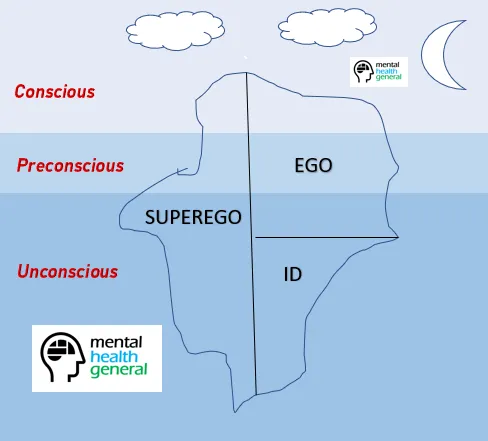Austrian neurologist Sigmund Freud had a number of theories, with his theory on Personality being one of the most well-known. Freud;s theory suggested that a human’s personality was made out of three connected areas – the id, the superego, and the ego.
In this article, we take a look at the “superego” element of Freud’s theory, as well as how it impacts mental health. For information on how the different parts of the personality compare, you can see our overview article here.
Embed from Getty ImagesFreud’s Theory of Personality
Freud’s theory of personality is based on the idea that there are three components of personality – the id, the Ego, and the Superego. They link to what Freud calls the conscious, unconscious and preconscious mind.
Freud believes that the id is the part of our personality that aims to satisfy basic needs; the superego is “the parent in our head” that looks out for our best interests; and the ego is the part of our personality that balances out the urges from the id and the superego.
Freud likened personality to an iceberg; an individual can only see a small piece of personality (i.e. the tip of the iceberg above the water), with most hidden away from view (like the iceberg).
The tip of the iceberg refers to what a person is aware of, and the forefront of the mind – as they are aware, it is considered to be the “conscious mind“. But under the water, there is an “unconscious mind” – where hidden thoughts, memories, feelings and desires are present [1].

What is the superego?
The superego is generally seen as a person’s conscience – or, as Freud put it – the “parent in our head”. The superego, like any caring parent, is watching us, analysing us, and helps to judge the desires of the id.
For instance, if someone was at a party and they were offered a substance, the id would be compelled to take the substance due to the high they would potentially encounter. But the superego suggests that is wrong, and that it is dangerous.
The ego provides the middle ground between the two, and comes to a rational decision. But in order to achieve a positive decision – the ego must engage in certain mental tricks, which help push harmful impulses in the unconscious mind.
When does the superego develop?
Freud suggests that the superego is the final part of the personality to develop. It follows the id (the part of personality that aims to satisfy basic needs) and the ego (the part of personality that balances out urges from the id and the superego to ensure a person acts in a way in keeping with societal norms).
The id is present from birth, while the ego develops in the first three years of life. This is followed by the superego, which usually develops around the age of 5 – so last of the three areas.
A person’s ideals in life that form the superego is based on a number of areas – such as societal norms, cultural norms, parent’s input, and certain morals.
What are the two areas of the superego?
Freud went on further to suggest the superego is divided into two areas – the ego ideal and the conscience. The ego ideal serves the purpose of instilling certain rules to lead to good behaviour. This would commonly lead to a person being approved of by their parents – and the wider society.
When someone follows such rules, they will feel harmonious and valued. The ego ideal essentially attempts to make us become the person we want to be – the ideal person.
But what happens if someone doesn’t follow the rules put in place by the ego ideal? This is where the other area of the superego comes to the fore – it is known as the conscience.
The conscience is made up of certain rules that pertain to poor or ‘naughty’ behaviour. If someone doesn’t act in line with the ego ideal, then they will feel guilty. Behaviour that goes against the ego ideal would be seen as bad by the conscience.
What are the goals of the superego?
As briefly touched on earlier, the superego helps to judge the desires of the id, and will attempt to overwhelm any urges that are seen as bad. The superego will counter the urges of the id, leaving the ego to mediate between the two, to come to a sensible decision.
It could be argued that the superego is the sensible part of a mind, the id is the impulsive part, leaving the ego to make a decision based on the two contrasting thoughts in a way that leads to morally permissible actions in line with societal and cultural norms.
The link to mental health
According to Freud, mental disturbance arises when the ego isn’t able to maintain its control of the id and the superego. Perhaps their impulses become too strong, and they engage in harmful behaviour.
Freud’s theory states that this disparity between the three states is often caused by trauma from early childhood. This can lead to mental distress that requires treatment.
In modern-day mental health, these ideas are taken into account in psychoanalysis-inspired talking therapies like Psychoanalytical Psychotherapy and Psychodynamic Psychotherapy.
While the bulk of this theory is attributed to Sigmund Freud, his daughter Anna Freud also made contributions to the superego. This is a key part of personality theory, though its merit and validity have been questioned by a number of scholars.
Summary
The superego element of Freud’s theory of personality is an important area, and it continues to be relevant to the modern day. Many mental health professionals use these ideas in therapy.
We have articles on the other two parts of Freud’s personality theory – the id and the Ego. Furthermore, you can see more about Freud by seeing our list of articles about Freud here.
See Also
- Overview of Sigmund Freud and His Theories
- Freud’s Theory of the Id, the Ego and the Superego
- Freud’s Theory of the Id and Mental Health
- Freud’s Theory of the Ego and Mental Health
- Freud’s Theory of the Superego and Mental Health
- Explaining The Two Parts of the Superego According to Freud
Disclaimer
This website should be used purely for informational purposes, and does not intend to, nor should it ever, be used as a replacement for professional medical advice.
We strive to keep all of our pages updated, and ensure that our website is full of factual and in-depth information. However, we encourage you to browse this website with care.
As a reminder, this website and all content within it cannot and should not replace the advice of a trained medical professional. You can read our full disclaimer at this link.
Helplines
If you are struggling with your mental health, help is available. With the right support and treatment, you can make a recovery. For information on helplines, or if you are in a state of crisis, please visit our crisis page by clicking on the relevant link for your geographical location (United Kingdom), (United States), (International). You can also see how to get mental health treatment and the process involved by clicking this link.
References
[1] Freud, S., & Hall, G. S. (1920). A general introduction to psychoanalysis. Boni and Liveright: New York.

































